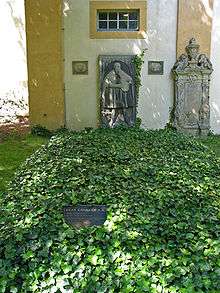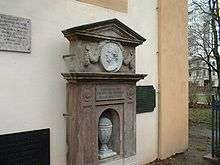Jacobsfriedhof
.jpg)
The Jacobsfriedhof, also known as the Jakobskirchhof ("St. James's Burial Ground" or "Churchyard"), is the oldest extant burial ground in Weimar, Thuringia, Germany, on land round the Jakobskirche (St. James's Church). The first burials took place here as early as the 12th century. The burial ground is located in the Jacobsvorstadt, which in the Middle Ages provided accommodation outside the city walls for pilgrims on their way to Santiago de Compostela (and today forms part of the historic Old Town under UNESCO protection).
From 1530 to 1818 it was the only burial ground in Weimar. After 1818, when the "Neue Friedhof vor dem Frauentore" ("New Burial Ground before the Gate of Our Lady") was opened, now known as the Historical Cemetery, Weimar, many of the graves in the Jacobsfriedhof were levelled. From 1840 no more burials took place here, and the burial ground fell slowly into disrepair. Later the Weimar municipal authorities took it over and converted the burial ground into gardens. The Jacobsfriedhof today is part of the Klassik Stiftung Weimar.
The Kassengewölbe
_auf_dem_Jacobsfriedhof2.jpg)
On the south-eastern edge of the Jacobfriedhof stands the mausoleum known as the Kassengewölbe, originally built in 1715 by a finance official as a private place of burial for himself and his family. In 1742 it became the property of the finance ministry or state exchequer, in German the Landeskasse, whence its present name Kassengewölbe: "exchequer vault". Since then it has principally served for the burials of people of high rank without the financial means for burials appropriate to their status. Such burials took place here from 1755 to 5 March 1823, including those of Luise von Göchhausen (a lady-in-waiting of Anna Amalia von Sachsen-Weimar-Eisenach) and the parents of Charlotte von Stein.
The present Baroque pavilion, formerly with a wrought-iron gate, that stands over the Kassengewölbe, is a reconstruction of 1913, as the original was levelled, with much of the burial ground, in 1854.
The Schiller Vault
_auf_dem_Jacobsfriedhof3_(cut).jpg)
Because of his title of Hofrat and his elevation into the aristocracy in 1802, Friedrich von Schiller, who died on 9 May 1805, was among those whose remains were buried in the Kassengewölbe. The mausoleum is thus often referred to as the "Schiller Vault" (Schiller-Gruft). After 1826 the Bürgermeister of Weimar, Carl Leberecht Schwabe, had had Schiller's remains retrieved from the Kassengewölbe. The exhumed bones believed to be the poet's were transferred in 1827 to an oak coffin in the newly built Fürstengruft in the Historical Burial Ground. In 2008 a DNA analysis, which attracted much attention, showed that the bones in the coffin could not have been those of Schiller, and since then the coffin, next to that of Goethe, has stood empty. It is generally presumed that Schiller's real remains were lost when the Kassengewölbe and the burial ground were levelled, although there are many other theories.
Notable graves


| Name | Dates | Noted as | Monument |
|---|---|---|---|
| Lucas Cranach the Elder | 1472–1553 | Court painter | Painters' Vault (Malergruft), inscription on south church wall |
| Georg Neumark | 1621–1681 | Poet and composer of hymns | |
| Johann Franz August Zimmermann | died 1774 | Footman; died during rescue operations in the castle fire of 1774 | Column in front of the Kassengewölbe |
| Johann Martin Mieding | 1725–1782 | Court cabinet maker and stage set maker | Memorial in the south-eastern part of the burial ground |
| Johann Karl August Musäus | 1735–1787 | Author, literary critic, philologist and collector of fairy tales | Monument with portrait and urn on the south church wall |
| Johann Joachim Christoph Bode | 1730–1793 | Translator, journalist, publisher, music teacher, Freemason, Illuminatus | Grave stone on the south church wall |
| Christiane Becker-Neumann | 1778–1797 | Actress, pupil of Goethe | Grave in the south-eastern part of the burial ground |
| Martin Gottlieb Klauer | 1742–1801 | Court sculptor and art teacher at the Fürstliche freie Zeichenschule Weimar | Urn on column in the north-eastern part of the burial ground |
| Johann Heinrich Löber | Court painter | Painters' Vault (Malergruft), gravestone on the south church wall | |
| Georg Melchior Kraus | 1737–1806 | Painter, engraver, friend of Goethe, director of the Fürstliche freie Zeichenschule | Painters' Vault (Malergruft), gravestone on the south church wall |
| Friedrich Wilhelm Carl von Schmettau | 1742–1806 | Lieutenant-General, topographer, cartographer and military author | Triangular stela with feather-crested helmet |
| Carl Ludwig Fernow | 1763–1808 | Art theorist and librarian | Memorial tablet on the north wall of the church |
| Maria Karoline Herder, née Flachsland | 1750–1809 | Wife of Johann Gottfried Herder (transferred to the Historical Cemetery during the 19th-century remodelling) | Grave formerly next to the east gate |
| Christian von Goethe, née Vulpius | 1765–1816 | Wife of Johann Wolfgang von Goethe | Inscription with farewell verses by Goethe |
| Christian Gottlob von Voigt | 1743–1819 | Poet, President of the State Ministry, ministerial colleague of Goethe | Sandstone sarcophagus at the burial ground's northern boundary |
| Ferdinand Jagemann | 1780–1820 | Painter, Professor at the Fürstliche freie Zeichenschule | Memorial tablet on the south wall of the church |
| Christoph Wilhelm Günther | 1755–1826 | Theologian, author of children's stories, court and garrison preacher, Oberkonsistorialrat in Weimar; in 1806 married J.W. von Goethe and Christiane Vulpius in the Jakobskirche | Memorial tablet on the north wall of the church |
Sources
- Hannelore Henze, Doris-Annette Schmidt: Der Jacobskirchhof in Weimar. Königswinter 1998
External links
| Wikimedia Commons has media related to Jakobsfriedhof Weimar. |
- Klassik-Stiftung.de: Kassengewölbe (in German)
Coordinates: 50°59′00″N 11°19′40″E / 50.98333°N 11.32778°E